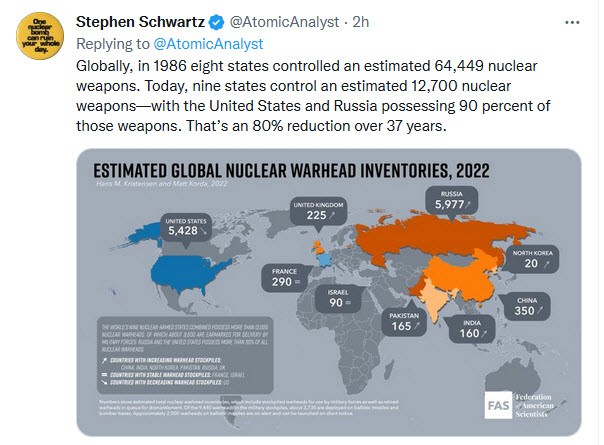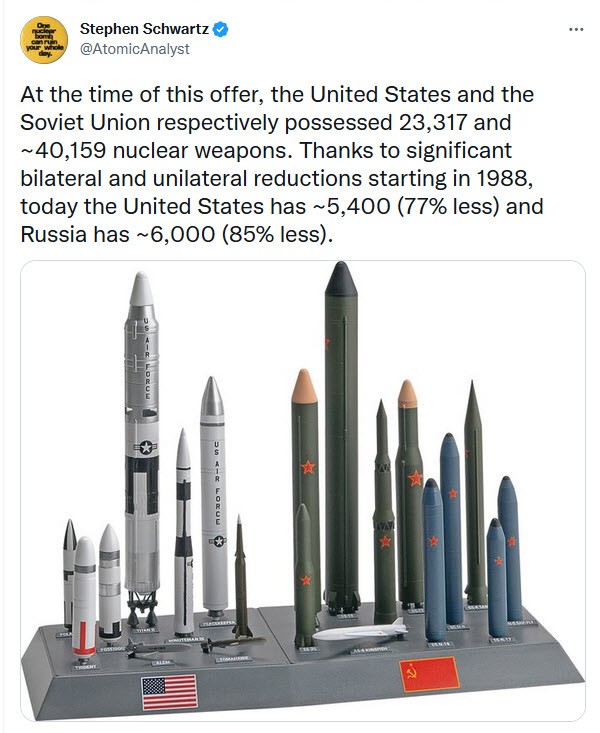The Doomsday Clock, first unveiled in the late 1940s when atomic scientists who built the first nuclear weapons were having second thoughts, is now closer to a midnight of disaster than ever before. We’ve arrived, humanity has arrived. The clock’s hands of fate display we’re on the brink of paroxysm and unimaginable cataclysm
The war between Russia and Ukraine is ratcheting and ratcheting. No one knows the endgame. Off-ramps to the war’s escalation are known unknowns. New weapons, more lethal weapons, are being mobilized and deployed. The missile attacks are seen by many as war crimes and the revenge factor is deep now, and growing.
The crisis on the battlefronts is real and a predicted widening of the war is inevitable, the strategists say, as the end of winter in Ukraine/Russia/Northern Europe arrives with vengeance.
The war crisis is a flashpoint focus of the atomic scientists this. The ‘experts’ running the Bulletin of the Atomic Scientists cite “the dangers of the war in Ukraine” as they announced the latest version of their Doomsday Clock. Yet there’s more. Mutual existential threats, costs of war, the climate crisis are being set aside.
For decades now the Clock has tick-tocked. Today’s crisis is the result of failed vision and failed policies, failures to negotiate, failures of political sanity. What are we to do with today’s reality at 90 seconds to midnight?
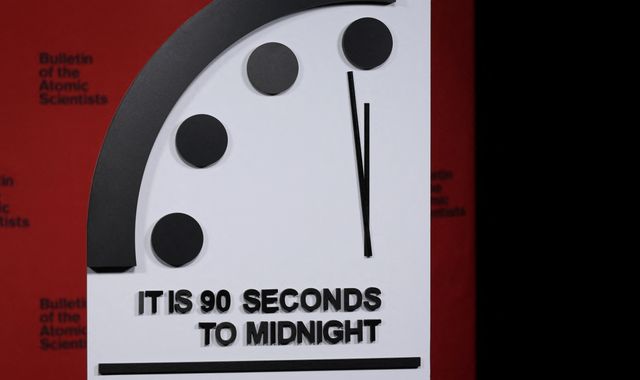
Strategic Demands:
The Ukraine-Russia war is a multiplying disaster, a multi-faceted war the mainstream press only begins to calculate and report. The consequences of the breakdown in pre-war nuclear weapons control negotiations are costs of war that are extensive, geo-political, realignments, rippling waves extending into the future, a physics of collapsing arms controls agreements. A new nuclear genie has been released.
The security offered by nuclear weapons reductions is gone. And now the new nuclear arms race has drawn in China with the Russian Federation to confront the U.S. and NATO most visibly, even as worldwide the nuclear-weapons states are ramping up their arsenals and nuclear want-to-be nations are rethinking their security strategies. North Korea is an example, one example, of a nuclear arms race that has now gone global.
A ticking tocking clock at 90 seconds to midnight does little justice to this reality that today’s and future generations will have to face, confront and deal with as the post WWII nuclear arms control architecture has collapsed.
The Ukraine-Russia crisis on the battlefields is the most visible part of this story, the news following the ratcheting up and deployment of more lethal tactical and strategic weapons. Going on in the shadows is the disinformation war, cyber warfare that’s accelerating and, as nations of the world face multiple existential threats, public leaders in democracies and authoritarian states are overwhelmed.
The war in Ukraine with Russia could have been avoided. For months prior to the announced “special operation”, that is, war Russian forces commenced on multiple fronts, they had announced they were not considering war but were negotiating. During this period, Strategic Demands for months prior to the war advanced a series of proposed solutions to the issues on the diplomatic table.
Our position is evident in the Strategic Demands banner under which we go forward — “Security is Indivisible”.
Our position in the proposed diplomatic solutions took into account the security of Ukraine and Russia. We focused on the next generation of nuclear weapons delivery systems and their perceived threats to both Ukraine and Russia, and NATO countries.
Those who stepped away from the negotiating table opened a veritable ‘pandora’s box’, a chaos theory of unpredictable consequences and ongoing crisis.
Decades ago during another war, a war in Vietnam and Southeast Asia that came near to the use of nuclear weapons (‘nuclear targets were picked‘), a US hit song intoned: “What are we fighting for?”.
So what are we fighting this time as the US ramps up this war, sending billions of dollars of weapons into Ukraine? Is it ‘quality of life’, ‘freedoms and rights’, ‘democratic decision-making’? These are worth protecting, preserving, even fighting for while, at the same time, strongly pushing for an end to an escalating nuclear arms race and perpetual war footing.
The nuclear threat, as with the bristling nuclear arms arsenals that were confronted by popular action in the 1960s/70s/80s, needs to be remembered. New precision nuclear weapons in development, capable of delivering a ‘nuclear Armageddon’ and an ‘end of times’, is now much closer today, too close.
We have spoken of a “physics of peace” as being necessary. Yet the path to new definitions of national security and a renewed nuclear weapons control architecture has become further from our grasp. Disaster is closer than ever, usable nukes are closer than ever. Proliferation, not non-proliferation, is the nuclear order of 2023… a horizon of escalating threats with a mistake, a miscalculation, a tech-glitch, a fail-safe gone wrong. Too many nuclear triggers can be pulled, chains of command jangled and computer codes auto-set to fire on warning. Per the Atomic Scientists, we’re on a precipice of doom.
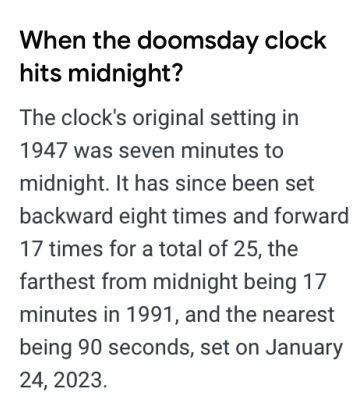
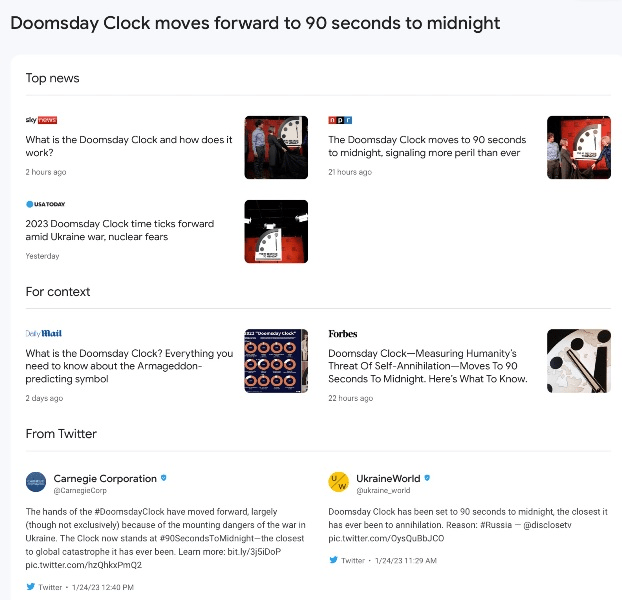
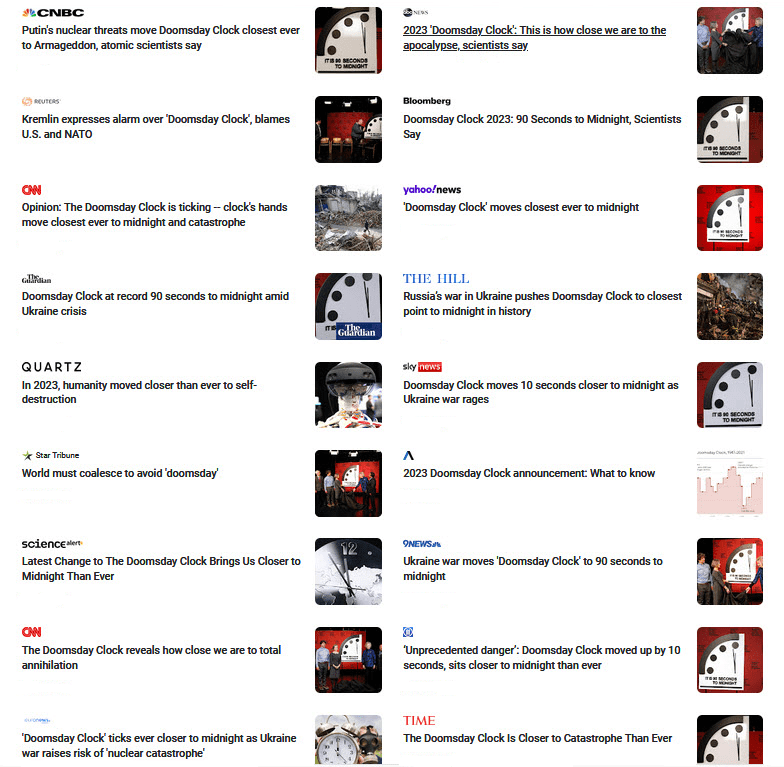
Can we ‘turn the hands of the Doomsday Clock back?’
Can we step back from the brink, draw down nuclear weapons, and negotiate nuclear arms controls and disarmament?
Recall a previous generation, its accomplishments to draw down nuclear weapon stockpiles and setting in place arms control agreements, communication systems and verification protocols. Now consider the ramp-up today of more ‘usable’ tactical, ‘dial up’ nuclear weapons, and forward-based, stealth/strike delivery systems….
The accelerating ‘modernization’ of nuclear forces, as William Perry warns, is in fact a deadlier era surpassing the shear numbers of nuclear weapons of the previous generation.
It is time for mutual security and vision.
It is time to turn away from failed policies of war.
Too much is at risk to continue on a war path with usable nukes.
‘A change has gotta come.’
♠
